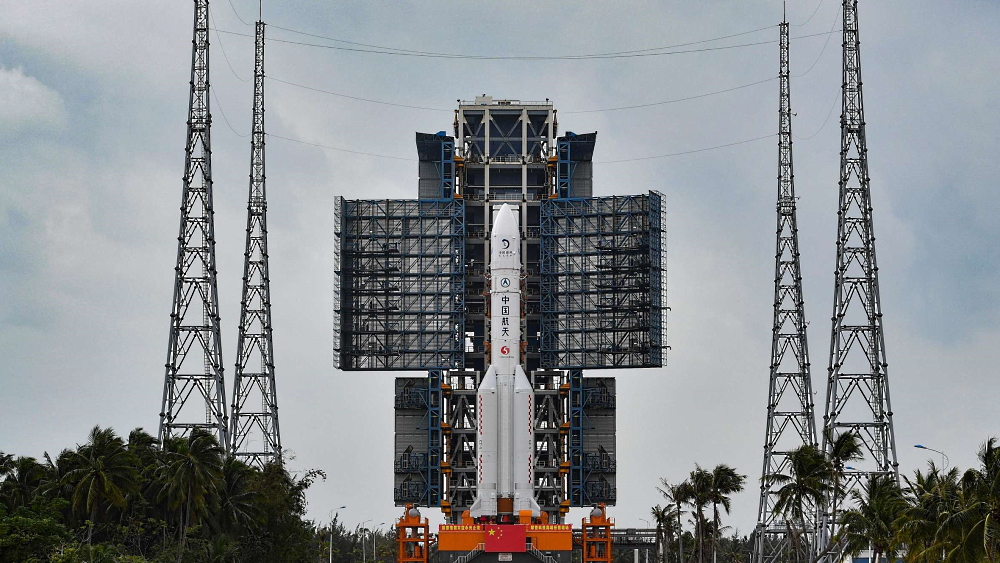
Photo: Xinhua
Another big step
China's lunar program rationally consists of successive, increasingly complex steps. It all started with orbiters. Chang'e-1 was launched on October 24 and entered the orbit of the Moon on November 5, 2007. The device was equipped with a stereo camera and collected data, which were used to build an accurate three-dimensional map of our natural satellite. A little less than two years later, the station was de-orbited and smashed against the Moon on March 1, 2009. Chang'e-2 was launched on October 1, 2010. The station entered an orbit with an altitude of 15 to 100 km and made it possible to map the Moon with a resolution of up to 1.3 meters per pixel. An interesting feature of the device was that it was not smashed and left in the orbit of the moon. June 8, 2011 "Chang'e-2" began the transition to the Lagrange point L 2of the Sun-Earth system (located behind the Earth), arriving there on August 25 and becoming the first interplanetary station in history to perform such a maneuver. The mission was extended further, and the spacecraft left point L 2 , exited the Earth's gravitational well, and on December 13, 2012 flew past the asteroid (4179) Tautatis. The completion of the mission has not yet been officially announced, and now the station is used to test communications over long distances.
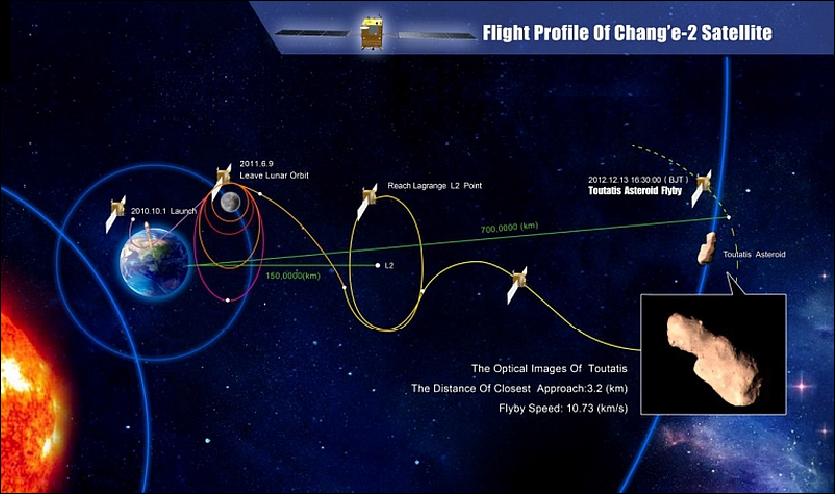
Big way of little "Chang'e-2"
The next logical step was a soft landing. Chang'e-3 took off on December 1, 2013 and landed successfully on the fourteenth. In addition to the lander (initial weight 3800 kg, dry 1200 kg), there was also a small rover Yuytu ("jade hare", in honor of the silhouette of a hare that can be seen on the Moon) weighing 120 kg. The rover traveled only 114.8 meters, but until 2016 worked as a motionless scientific laboratory. "Chang'e-3" is still functioning.

The panorama of the landing site
"Chang'e-4" also consisted of a lander and a rover, but for the first time in history it landed on the far side of the moon. Launched on December 7, 2018, it successfully landed in the von Karman crater on January 3, 2019. And in order to be able to communicate with it, preliminary, in 2018, in the area of point L 2In the Earth-Moon system, the "Quetqiao" satellite ("Magpie Bridge", according to legend, connecting lovers) was launched.

Fragment of the panorama of the landing site
The next obvious step is to return the soil. But first it was worth testing the technology. And the special test vehicle "Chang'e-5T1" took off on October 23, 2014, circled the moon and successfully returned to Earth on October 31.

Descent vehicle after landing
In terms of size and proportions, the descent vehicle is a reduced spacecraft of the Soyuz spacecraft (or in many respects the spacecraft of the Chinese spacecraft Shenzhou based on it). The successful return of "Soyuz" from the Moon in an unmanned version was tested back in the USSR ("Probes" 4-8), but one more test did not harm the case. And the booster block of the launch vehicle that flew with it went into orbit around the Moon, where it made two approaches to the calculated point to check the future Chang'e-5 docking.
Rocket
In the initial plans, the Chang'e-5 was supposed to fly back in 2017, but the launch vehicle turned out to be the main inhibiting factor. The device inevitably turned out to be quite heavy and required the heaviest available launch vehicle in China, the Long March 5 (25 tons to low orbit, 9.4 tons to the moon). However, in the second launch, on July 2, 2017, an accident occurred on one of the engines of the central unit (second stage), due to which the rocket and payload were lost. After the engine was reworked, new problems were discovered, which delayed the return to flights, and the "Long March" started again only on December 27, 2019. "Chang'e-5" will be only the sixth launch for this launch vehicle.
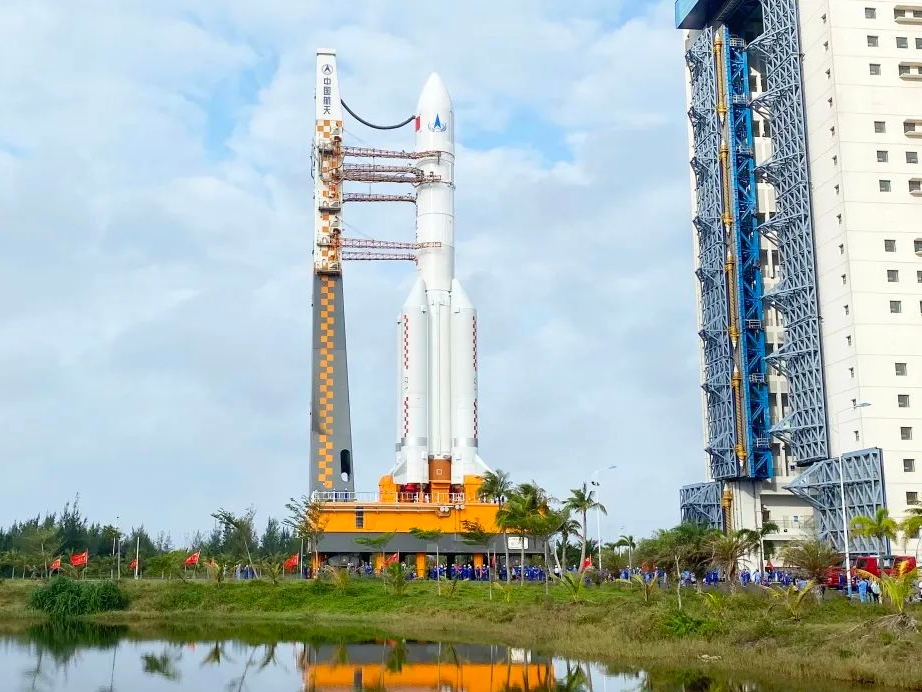
Removal of the rocket at the start
Flight plan
Unfortunately, we do not know about the exact start time and stages of the mission. Judging by the areas declared hazardous to shipping and aviation, the launch will take place on November 24 from 04:00 to 07:00 Beijing time (Monday to Tuesday night from 23:00 to 02:00 Moscow time). Other sources, according to alleged insider information, call 20:25 - 21:15 UTC (23:25 - 00:15 Moscow time). They also try to guess the date of landing on the moon from, for example, footage from the rehearsal of the mission. If the extrapolation is correct, then Chang'e-5 should land around 20:30 UTC on November 29th. The duration of the mission has been announced at 23 days, so the return of the lander should be expected around December 15th. The stages of the mission are also known only in general terms.

Flight plan
In the lunar orbit, the vehicles are separated - the flight stage and the descent vehicle remain in orbit, the landing and take-off stages land. The device collects approximately 2 kilograms of soil samples, from the surface and through drilling, and loads them into the take-off stage. The takeoff stage enters orbit and loads the samples into the descent vehicle. The flight stage with the descent vehicle is sent to Earth, and the descent vehicle with the samples makes a soft landing in the usual place, Inner Mongolia. In fact, this is an unmanned mini-Apollo, there were the same four stages, except that the docking was performed by a person using a computer and instruments. It is curious that the Soviet soil recovery stations had only three stages. The first provided flight and landing, and the second was launched with a descent vehicle.The trick of the Soviet ballistics was that the second stage was launched at exactly the right time, strictly vertically and turned off the engine when a certain speed was reached. In this case, without any corrections of the trajectory, the descent vehicle got into the calculated landing area on Earth, albeit with a huge, more than 300 "same", overload.
Flight plan in video
Station

Station in the assembly and testing complex
It is known that the total mass of the Chang'e-5 is 8.2 tons, the landing stage is estimated at 3.8 tons, and the take-off stage at 120 kg. The landing stage is equipped with cameras, a spectrometer, soil analysis instruments and a ground penetrating radar. Sample collection includes a manipulator, surface samplers, impact drill, transport and loading mechanism, and sample containers. Equipping the landing stage with scientific equipment hints that it can work for a long time, but at the same time there is information that it does not have a radioisotope heater to survive a two-week lunar night.

3D model of the station
Landing place
The area of Rumker Peak in the Ocean of Storms was chosen as the estimated landing site. Young basalts there are very interesting for geologists.
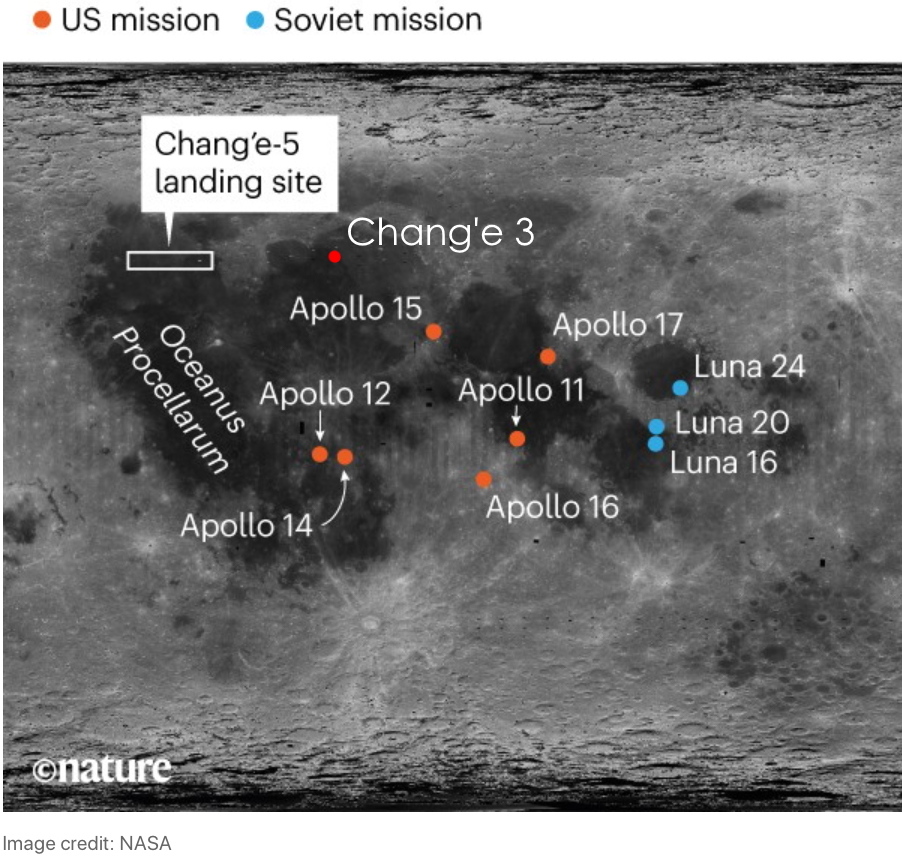
Landing area relative to other missions

Several possible landing sites
Mission escort
On the website of the European Space Agency, you can find out that its tracking stations will participate in the mission - shortly after the launch, Chang'e-5 will track the station in Kourou (French Guiana), and shortly before landing - Maspalomas station (Canary Islands).
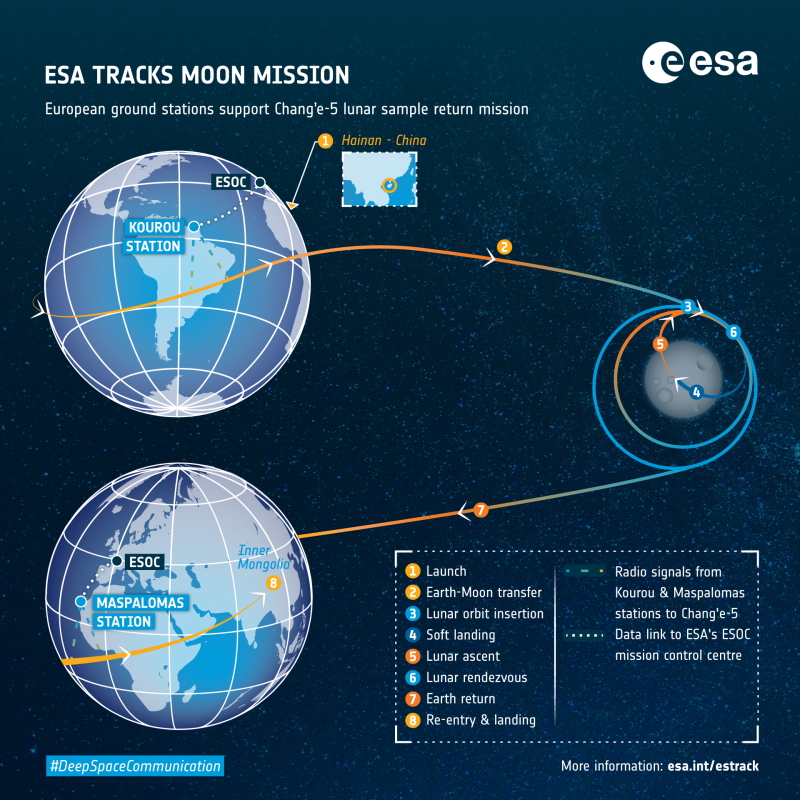
In China, just a few days ago, a complex of four 35-meter antennas was put into operation at the Kashi (“Kashgar”) station of the Xi'an Satellite Control Center. Also, the long-distance communications ship "Yuanwan-3" left the port to communicate with the device.
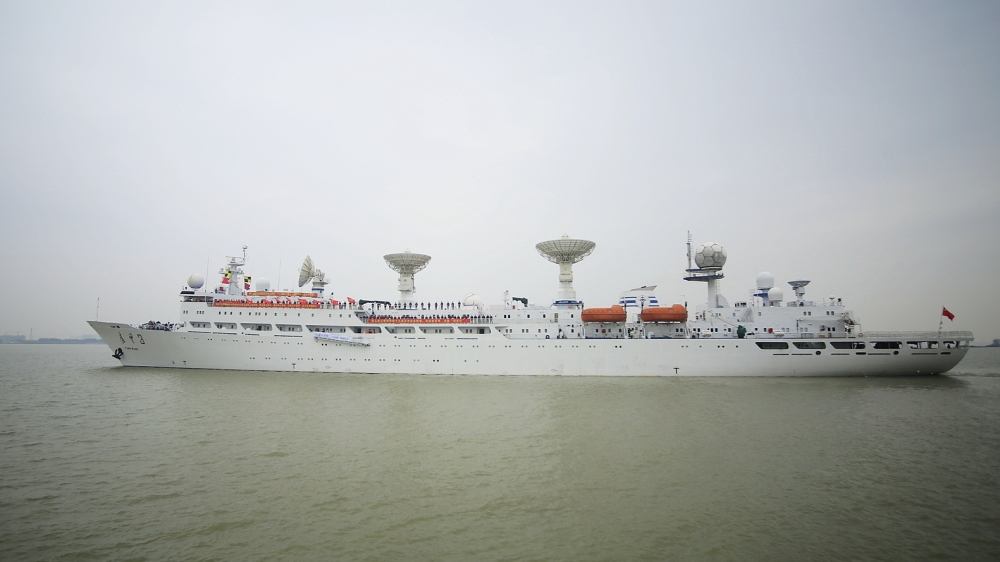
Emblem and name
It is curious that the mission has as many as four emblems:

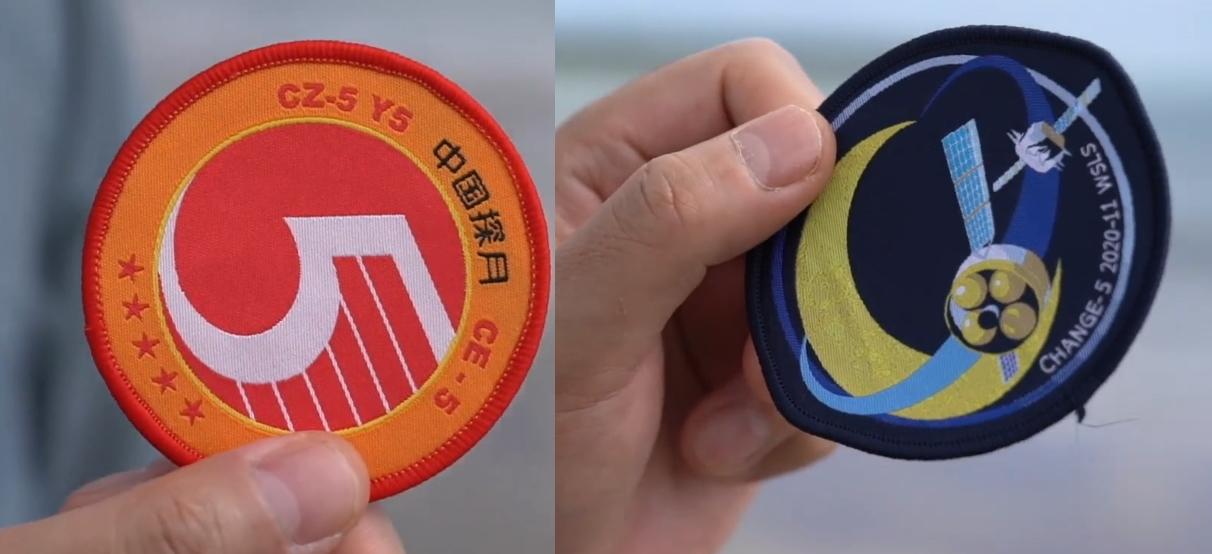
Like the previous devices of the series, "Chang'e-5" is named after the goddess of the moon.
Conclusion
If the Chang'e-5 mission is successful, then the sixth and subsequent vehicles will operate in the region of the South Pole. "Chang'e-6" will deliver soil samples to Earth, the seventh vehicle will carry a landing station, a rover and a "jumper", which will move over the surface by jumping on rocket engines. Chang'e-8, in addition to scientific equipment, will carry technological demonstrators of resource extraction and construction of facilities to test the technologies of a manned lunar base, which is planned to be built in the 2030s.